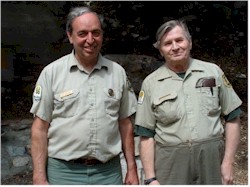|
When I first got the Mount Lowe bug in 1972 I went to the Pasadena City Library. In a notebook there I saw a 1957 Star News article about Robert Wilde and his Mount Lowe collection. I thought at the time that I would never cross paths with him.
Robert attended the Mt Lowe centennial at Echo Mtn. on a cold foggy Fourth of July. Robert had been volunteering in the Forest since the early 1980’s but was not active when we started working at Mt. Lowe. Sometime in 1994, Paul Ayers met Robert at the Central Library in Los Angeles. He was in LA on Jury Duty and the two were looking at the Mt. Lowe collection. Paul contacted me afterward and as he described Robert, I knew he was the same Robert from the article I saw in 1972. That year Robert started working with us and shared information and photos that he had carefully organized over the years. I was especially impressed how he documented everything he did. Especially when it came to Mt. Lowe. In fact, he sometimes drove me nuts making sure he got the correct dates, times, and places of photos I would share of our workdays at Mt. Lowe. Everytime I would pick him up for our work party trips to the mountain, he pulled out a little notepad and recorded the time we left his house, when we arrived to our destination etc…I believe he had a record of every time in his life that he had been to Mt. Lowe or anywhere else in the Forest. One day he brought along his notebooks. In each of them were photos he had taken with his box camera in the 50’s. He documented in each of these pictures the ruins of buildings... for example the Powerhouse on Echo Mountain. He documented inside and out the details of the building. Each of the books included the date, time and when he arrived at each site. Just as he had done right up to his last trip to Mount Lowe Campground this last Spring. The trail that now leads from the fire road to Echo Mountain along the right-of-way at one time was much more difficult to hike. At that time one would have to climb down and back up at each Trestle site. In the 60’s the Forest Service bridged the Trestle areas making it an easy hike to Echo Mountain. He once owned a cabin in Grand Canyon just below Granite gate. He often talked about just how long it took to get there before the flashlight batteries would wear out. He wandered in the darkness a few times. Robert supplied much of the historical background that was so important as we tried to piece together things we were discovering as we cleared brush and surveyed the area. He did not see this hobby of his as any big challenge, it was his labor of love. The greatest contribution he made came from one of his late 1950’s visits to the original Inspiration Point shelter. I had seen a few pictures of it over the years, but none like the pictures that Robert took. He stood under the original shelter and took a picture of the underside of the roof with all the complicated beam and rafter arrangement. Without that picture we could not have made it historically correct. I asked him a number of times what were he was thinking when he took the photo?And did he ever think that it would make it possible to reconstruct Inspiration Point some day? Anyone that knew Robert very well has probably figured out by now that I never received an answer. He just loved Mount Lowe and wanted to save the memories of that day. In the 12 years I have known him He has taught me a lot about friendship. Robert treated others with great respect. He knew the value friends. Because of the reconstructed shelter Inspiration Point is a very popular destination for those that visit the Forest today. We are grateful for the important role he has played in the History of the Mount Lowe Railway. Brian Marcroft
|
 Fast
forward to 1991 when our group started working in the forest with Jim
Spencer.
Fast
forward to 1991 when our group started working in the forest with Jim
Spencer.